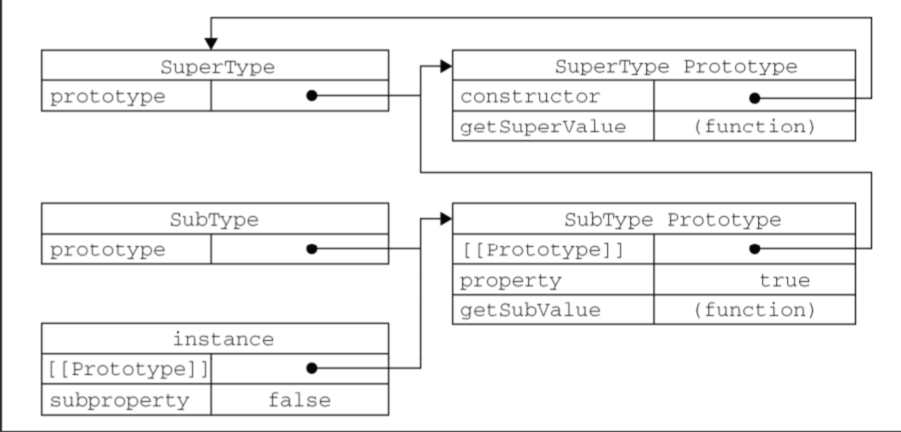原型&继承题目及内容解答
这里给大家分享我在网上总结出来的一些知识,希望对大家有所帮助
1. 代码输出结果
function Person(name) {
this.name = name
}
var p2 = new Person('king');
console.log(p2.__proto__) //Person.prototype
console.log(p2.__proto__.__proto__) //Object.prototype
console.log(p2.__proto__.__proto__.__proto__) // null
console.log(p2.__proto__.__proto__.__proto__.__proto__)//null后面没有了,报错
console.log(p2.__proto__.__proto__.__proto__.__proto__.__proto__)//null后面没有了,报错
console.log(p2.constructor)//Person
console.log(p2.prototype)//undefined p2是实例,没有prototype属性
console.log(Person.constructor)//Function 一个空函数
console.log(Person.prototype)//打印出Person.prototype这个对象里所有的方法和属性
console.log(Person.prototype.constructor)//Person
console.log(Person.prototype.__proto__)// Object.prototype
console.log(Person.__proto__) //Function.prototype
console.log(Function.prototype.__proto__)//Object.prototype
console.log(Function.__proto__)//Function.prototype
console.log(Object.__proto__)//Function.prototype
console.log(Object.prototype.__proto__)//null
这道义题目考察原型、原型链的基础,记住就可以了。
2. 代码输出结果
// a
function Foo () {
getName = function () {
console.log(1);
}
return this;
}
// b
Foo.getName = function () {
console.log(2);
}
// c
Foo.prototype.getName = function () {
console.log(3);
}
// d
var getName = function () {
console.log(4);
}
// e
function getName () {
console.log(5);
}
Foo.getName(); // 2
getName(); // 4
Foo().getName(); // 1
getName(); // 1
new Foo.getName(); // 2
new Foo().getName(); // 3
new new Foo().getName(); // 3
输出结果:2 4 1 1 2 3 3
解析:
- Foo.getName(),Foo为一个函数对象,对象都可以有属性,b 处定义Foo的getName属性为函数,输出2;
- getName(),这里看d、e处,d为函数表达式,e为函数声明,两者区别在于变量提升,函数声明的 5 会被后边函数表达式的 4 覆盖;
- Foo().getName(),这里要看a处,在Foo内部将全局的getName重新赋值为 console.log(1) 的函数,执行Foo()返回 this,这个this指向window,Foo().getName() 即为window.getName(),输出 1;
- getName(),上面3中,全局的getName已经被重新赋值,所以这里依然输出 1;
- new Foo.getName(),这里等价于 new (Foo.getName()),先执行 Foo.getName(),输出 2,然后new一个实例;
- new Foo().getName(),这里等价于 (new Foo()).getName(), 先new一个Foo的实例,再执行这个实例的getName方法,但是这个实例本身没有这个方法,所以去原型链__protot__上边找,实例.__protot__ === Foo.prototype,所以输出 3;
- new new Foo().getName(),这里等价于new (new Foo().getName()),如上述6,先输出 3,然后new 一个 new Foo().getName() 的实例。
3. 代码输出结果
var F = function() {};
Object.prototype.a = function() {
console.log('a');
};
Function.prototype.b = function() {
console.log('b');
}
var f = new F();
f.a();
f.b();
F.a();
F.b()
输出结果:
a Uncaught TypeError: f.b is not a function a b
解析:
- f 并不是 Function 的实例,因为它本来就不是构造函数,调用的是 Function 原型链上的相关属性和方法,只能访问到 Object 原型链。所以 f.a() 输出 a ,而 f.b() 就报错了。
- F 是个构造函数,而 F 是构造函数 Function 的一个实例。因为 F instanceof Object === true,F instanceof Function === true,由此可以得出结论:F 是 Object 和 Function 两个的实例,即 F 能访问到 a, 也能访问到 b。所以 F.a() 输出 a ,F.b() 输出 b。
4. 代码输出结果
function Foo(){
Foo.a = function(){
console.log(1);
}
this.a = function(){
console.log(2)
}
}
Foo.prototype.a = function(){
console.log(3);
}
Foo.a = function(){
console.log(4);
}
Foo.a();
let obj = new Foo();
obj.a();
Foo.a();
输出结果:4 2 1
解析:
- Foo.a() 这个是调用 Foo 函数的静态方法 a,虽然 Foo 中有优先级更高的属性方法 a,但 Foo 此时没有被调用,所以此时输出 Foo 的静态方法 a 的结果:4
- let obj = new Foo(); 使用了 new 方法调用了函数,返回了函数实例对象,此时 Foo 函数内部的属性方法初始化,原型链建立。
- obj.a() ; 调用 obj 实例上的方法 a,该实例上目前有两个 a 方法:一个是内部属性方法,另一个是原型上的方法。当这两者都存在时,首先查找 ownProperty ,如果没有才去原型链上找,所以调用实例上的 a 输出:2
- Foo.a() ; 根据第2步可知 Foo 函数内部的属性方法已初始化,覆盖了同名的静态方法,所以输出:1
5. 代码输出结果
function Dog() {
this.name = 'puppy'
}
Dog.prototype.bark = () => {
console.log('woof!woof!')
}
const dog = new Dog()
console.log(Dog.prototype.constructor === Dog && dog.constructor === Dog && dog instanceof Dog)
输出结果:true
解析:
因为constructor是prototype上的属性,所以dog.constructor实际上就是指向Dog.prototype.constructor;constructor属性指向构造函数。instanceof而实际检测的是类型是否在实例的原型链上。
constructor是prototype上的属性,这一点很容易被忽略掉。constructor和instanceof 的作用是不同的,感性地来说,constructor的限制比较严格,它只能严格对比对象的构造函数是不是指定的值;而instanceof比较松散,只要检测的类型在原型链上,就会返回true。
6. 代码输出结果
var A = {n: 4399};
var B = function(){this.n = 9999};
var C = function(){var n = 8888};
B.prototype = A;
C.prototype = A;
var b = new B();
var c = new C();
A.n++
console.log(b.n);
console.log(c.n);
输出结果:9999 4400
解析:
- console.log(b.n),在查找b.n是首先查找 b 对象自身有没有 n 属性,如果没有会去原型(prototype)上查找,当执行var b = new B()时,函数内部this.n=9999(此时this指向 b) 返回b对象,b对象有自身的n属性,所以返回 9999。
- console.log(c.n),同理,当执行var c = new C()时,c对象没有自身的n属性,向上查找,找到原型 (prototype)上的 n 属性,因为 A.n++(此时对象A中的n为4400), 所以返回4400。
7. 代码输出问题
function A(){
}
function B(a){
this.a = a;
}
function C(a){
if(a){
this.a = a;
}
}
A.prototype.a = 1;
B.prototype.a = 1;
C.prototype.a = 1;
console.log(new A().a);
console.log(new B().a);
console.log(new C(2).a);
输出结果:1 undefined 2
解析:
- console.log(new A().a),new A()为构造函数创建的对象,本身没有a属性,所以向它的原型去找,发现原型的a属性的属性值为1,故该输出值为1;
- console.log(new B().a),ew B()为构造函数创建的对象,该构造函数有参数a,但该对象没有传参,故该输出值为undefined;
- console.log(new C(2).a),new C()为构造函数创建的对象,该构造函数有参数a,且传的实参为2,执行函数内部,发现if为真,执行this.a = 2,故属性a的值为2。
8 代码输出问题
function Parent() {
this.a = 1;
this.b = [1, 2, this.a];
this.c = { demo: 5 };
this.show = function () {
console.log(this.a , this.b , this.c.demo );
}
}
function Child() {
this.a = 2;
this.change = function () {
this.b.push(this.a);
this.a = this.b.length;
this.c.demo = this.a++;
}
}
Child.prototype = new Parent();
var parent = new Parent();
var child1 = new Child();
var child2 = new Child();
child1.a = 11;
child2.a = 12;
parent.show();
child1.show();
child2.show();
child1.change();
child2.change();
parent.show();
child1.show();
child2.show();
输出结果:
parent.show(); // 1 [1,2,1] 5 child1.show(); // 11 [1,2,1] 5 child2.show(); // 12 [1,2,1] 5 parent.show(); // 1 [1,2,1] 5 child1.show(); // 5 [1,2,1,11,12] 5 child2.show(); // 6 [1,2,1,11,12] 5
这道题目值得神帝,他涉及到的知识点很多,例如this的指向、原型、原型链、类的继承、数据类型等。
解析:
- parent.show(),可以直接获得所需的值,没啥好说的;
- child1.show(),
Child的构造函数原本是指向Child的,题目显式将Child类的原型对象指向了Parent类的一个实例,需要注意Child.prototype指向的是Parent的实例parent,而不是指向Parent这个类。 - child2.show(),这个也没啥好说的;
- parent.show(),
parent是一个Parent类的实例,Child.prorotype指向的是Parent类的另一个实例,两者在堆内存中互不影响,所以上述操作不影响parent实例,所以输出结果不变; - child1.show(),
child1执行了change()方法后,发生了怎样的变化呢?
- this.b.push(this.a),由于this的动态指向特性,this.b会指向
Child.prototype上的b数组,this.a会指向child1的a属性,所以Child.prototype.b变成了[1,2,1,11]; - this.a = this.b.length,这条语句中
this.a和this.b的指向与上一句一致,故结果为child1.a变为4; - this.c.demo = this.a++,由于
child1自身属性并没有c这个属性,所以此处的this.c会指向Child.prototype.c,this.a值为4,为原始类型,故赋值操作时会直接赋值,Child.prototype.c.demo的结果为4,而this.a随后自增为5(4 + 1 = 5)。
child2执行了change()方法, 而child2和child1均是Child类的实例,所以他们的原型链指向同一个原型对象Child.prototype,也就是同一个parent实例,所以child2.change()中所有影响到原型对象的语句都会影响child1的最终输出结果。
- this.b.push(this.a),由于this的动态指向特性,this.b会指向
Child.prototype上的b数组,this.a会指向child2的a属性,所以Child.prototype.b变成了[1,2,1,11,12]; - this.a = this.b.length,这条语句中
this.a和this.b的指向与上一句一致,故结果为child2.a变为5; - this.c.demo = this.a++,由于
child2自身属性并没有c这个属性,所以此处的this.c会指向Child.prototype.c,故执行结果为Child.prototype.c.demo的值变为child2.a的值5,而child2.a最终自增为6(5 + 1 = 6)。
9. 代码输出结果
function SuperType(){
this.property = true;
}
SuperType.prototype.getSuperValue = function(){
return this.property;
};
function SubType(){
this.subproperty = false;
}
SubType.prototype = new SuperType();
SubType.prototype.getSubValue = function (){
return this.subproperty;
};
var instance = new SubType();
console.log(instance.getSuperValue());




